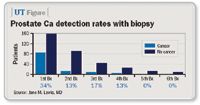Article
Study suggests stopping prostate biopsies after four
Author(s):
Chicago-Sextant biopsy with a transition zone or a laterally directed template loses efficacy in prostate cancer diagnosis with repeat testing, but only after four negative biopsies have been taken, researchers from Harvard Medical School reported at the American College of Surgeons clinical congress here.

This finding emerged from a retrospective study designed to investigate the utility of repeat transrectal ultrasound-guided prostate needle biopsy in prostate cancer detection.
In a series of 241 men who had undergone between one and six biopsies, the cancer detection rate was 34% for the first biopsy (82/241) and decreased into the range of 13% to 17% for the second (13/102), third (9/53), and fourth (4/30) biopsies. Thirteen men had five biopsies, and ten underwent six procedures. None of those tests yielded a cancer diagnosis.

The patients included in the study were part of a larger cohort of approximately 2,000 men who had undergone sextant TRUS prostate needle biospy at Brigham and Women's Hospital between January 2001 and January 2004. Initially, 400 men were selected randomly for analysis. Their medical records were reviewed for PSA data and information from biopsies performed at BWH prior to 2001. Further analyses were based on 241 men who had a PSA value in the range of >4.0 to <20.0 ng/dL with or without an abnormal digital rectal exam.
"Although recommendations for a PSA value that warrants biopsy have changed in recent years, during the period of our study, 4.0 ng/dL was considered the norm," explained Dr. Lewis, currently a pediatric urology fellow at Northwestern University, Chicago.
The men were analyzed for each biopsy event performed. All groups were similar in mean number of cores obtained. As expected, the mean age of the patient and the mean prostate volume increased slightly as the number of procedures performed increased. Mean PSA and PSA density did not vary among groups.
Dr. Lewis observed that the results of this study are consistent with data reported in 2002 by Roehl et al (J Urol 2002; 167:2435-9). That study analyzed prostate cancer diagnosis outcomes in more than 2,500 men who underwent biopsy for cause. In that series, the first biopsy was positive in 29% of men, and the yield decreased successively thereafter. However, a fifth biopsy resulted in cancer diagnosis in 9% of men and was positive for cancer in 7% of men who had a sixth biopsy.
"Their finding of cancer after more than four previous biopsies may simply reflect the larger number of patients studied. Of note, 99% of all cancers detected within the large patient cohort were found in the first four biopsies," Dr. Lewis said.
Although multiple repeat biopsies may be considered the equivalent of a saturation biopsy, Dr. Lewis observed that the former approach may be preferred from a safety perspective.
Newsletter
Stay current with the latest urology news and practice-changing insights — sign up now for the essential updates every urologist needs.















